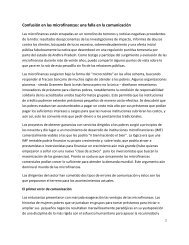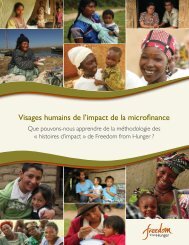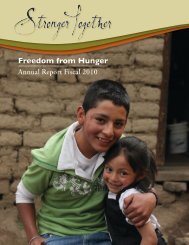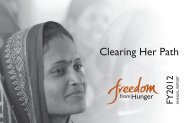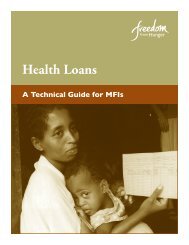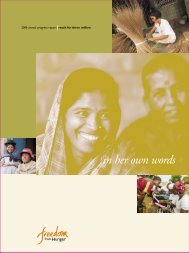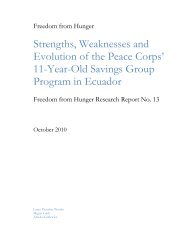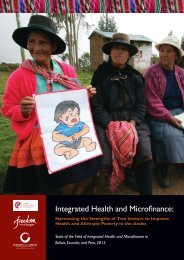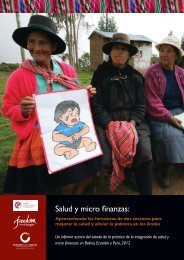history of meals for millions, soy, and freedom from ... - SoyInfo Center
history of meals for millions, soy, and freedom from ... - SoyInfo Center
history of meals for millions, soy, and freedom from ... - SoyInfo Center
Create successful ePaper yourself
Turn your PDF publications into a flip-book with our unique Google optimized e-Paper software.
finishing his career as a high-ranking executive. He was an<br />
activist on <strong>and</strong> chair <strong>of</strong> many boards (including the<br />
Minnesota Opera, the Minnesota Orchestra, Minnesota<br />
Public Radio, FFH, etc.). Tom was an outst<strong>and</strong>ing chair <strong>of</strong><br />
the FFH board. He always allowed <strong>for</strong> plenty <strong>of</strong> discussion<br />
<strong>and</strong> then would cut it <strong>of</strong>f at just the right moment, stay on<br />
time <strong>for</strong> topic. The meetings always started <strong>and</strong> ended right<br />
on time, yet everyone felt included in the discussion by the<br />
time the votes were taken. He was a visionary, <strong>and</strong>, like<br />
Christopher, was deeply committed to the intellectual<br />
dimension <strong>and</strong> to proving impact. He visited many <strong>of</strong> FFH’s<br />
programs worldwide, always paid his own way, <strong>and</strong> was<br />
<strong>of</strong>ten deeply moved by the what he saw as a result <strong>of</strong> FFH’s<br />
programs. He had a huge heart (everyone could feel that)<br />
with unusual wisdom <strong>and</strong> business acumen–a rare<br />
combination. Tom <strong>and</strong> Christopher worked very well<br />
together; they made a superb team.<br />
FFH moved to Davis, Cali<strong>for</strong>nia, <strong>from</strong> Santa Monica in<br />
about 1982 <strong>and</strong> on 20 March 1983 their newly constructed<br />
international center was dedicated. Davis was chosen <strong>for</strong> its<br />
agricultural university <strong>and</strong> its leadership in agriculture. In<br />
those days FFH’s main activity was still applied nutrition,<br />
which involved applied technology, using bamboo <strong>for</strong><br />
irrigation pipes, <strong>and</strong> much more crop-related resources. In<br />
addition, FFH wanted to be near an international airport <strong>and</strong><br />
to the general resources <strong>of</strong> the university <strong>from</strong> libraries to<br />
experts. Throughout its long <strong>history</strong>, MFM / FFH has<br />
discussed moving <strong>from</strong> the “wrong coast” to the east coast<br />
(which would aid in recruiting staff, communicating with<br />
major organizations in the field) but sunny, innovative<br />
Cali<strong>for</strong>nia has always won out in the end–<strong>and</strong> its distance<br />
<strong>from</strong> the center <strong>of</strong> action (“the thick <strong>of</strong> it”) does have<br />
definite advantages. Address: Manager, Donor<br />
Communications, Freedom <strong>from</strong> Hunger, 1644 DaVinci<br />
Court, Davis, Cali<strong>for</strong>nia 95616.<br />
371. Dodson, Chris. 2011. Recent <strong>history</strong> <strong>of</strong> Freedom <strong>from</strong><br />
Hunger: The story behind the annual reports (Continued–<br />
Part III). SoyaScan Notes. Jan. 9. Conducted by William<br />
Shurtleff <strong>of</strong> Soyinfo <strong>Center</strong>.<br />
• Summary: Continued: Question: What has been the effect<br />
on FFH <strong>and</strong> its programs <strong>of</strong> the large grant received <strong>from</strong><br />
the Bill & Melinda Gates Foundation?<br />
CD: Gates was the foundation that funded the Micr<strong>of</strong>inance<br />
<strong>and</strong> Health Protection (MAHP) program. FFH proposed the<br />
program to Gates <strong>and</strong> Gates said, “yes,” that they were<br />
interested. It was a 5-year grant. Gates had never been in<br />
micr<strong>of</strong>inance at that time, so on the recommendation <strong>of</strong> Sam<br />
Daley-Harris at the Microcredit Summit Campaign, who<br />
had worked with Christopher to keep micr<strong>of</strong>inance focused<br />
on the poorest <strong>of</strong> the poor, to a meeting. In March 2005 they<br />
met in San Francisco; the Gates people didn’t want to talk<br />
about Freedom <strong>from</strong> Hunger at all; they just wanted to talk<br />
about the micr<strong>of</strong>inance community <strong>and</strong> the potential. In<br />
MEALS FOR MILLIONS, SOY, AND FREEDOM FROM HUNGER 172<br />
© Copyright Soyinfo <strong>Center</strong> 2011<br />
June the Gates foundation called to say they were putting<br />
out a request <strong>for</strong> proposals in the field <strong>of</strong> micr<strong>of</strong>inance to<br />
six organizations <strong>and</strong> FFH was one <strong>of</strong> them. The proposal<br />
was due Sept. 2. FFH took a big breath, let out a loud<br />
“whoop,” <strong>and</strong> then settled down to try to craft a proposal. It<br />
had to be filled with new ideas, because Gates likes to fund<br />
only innovative projects. In about the 2nd week in July<br />
Gates called to ask: “Is FFH planning to submit a<br />
proposal?” FFH said “Yes.” And they said, “How come we<br />
haven’t heard <strong>from</strong> you? We’ll help you with the details <strong>of</strong><br />
the proposal <strong>and</strong> its submission. Why don’t you talk to us?”<br />
So that’s how the world <strong>of</strong> Gates works! What a relief. But<br />
they didn’t direct or shape the proposal in any way. FFH<br />
had always been focused on “integrated services <strong>of</strong><br />
micr<strong>of</strong>inance”–its long-time specialty <strong>and</strong> innovation–<strong>and</strong><br />
more specifically “integrating health with micr<strong>of</strong>inance.”<br />
FFH got the proposal in on time <strong>and</strong> was one <strong>of</strong> four<br />
organizations that was awarded a major grant on the first<br />
round; they also got the largest grant.<br />
Now, the five years have passed <strong>and</strong> FFH has just this<br />
summer reported everything that it has learned <strong>from</strong> MAHP.<br />
It was “blockbuster.” They thought they would reach 30,000<br />
people; they ended up reaching 300,000. As the 2010<br />
annual report states: “The average annual cost <strong>of</strong> adding<br />
health protection services to micr<strong>of</strong>inance programs is only<br />
29¢ per person... <strong>and</strong> some services can be expected to more<br />
than break even generating modest pr<strong>of</strong>its at larger scale.”<br />
Each <strong>of</strong> the program highlights is bulleted.<br />
Counting the number <strong>of</strong> women who get loans plus<br />
integrated services is a big, complex job. Part <strong>of</strong> the<br />
complexity is that FFH is working with 112 partners around<br />
the world; it asks each <strong>of</strong> those partners to submit the<br />
number <strong>of</strong> women served twice a year. It’s a very big<br />
project. While FFH has less connection with the lowincome<br />
women in the field than they did, say, ten years ago,<br />
that also means that FFH is reaching many, many more<br />
women. In the early 2000s FFH decided that, since they<br />
have this proven Credit with Education program that<br />
they’ve been working on <strong>for</strong> ten years (all the lessons,<br />
techniques <strong>for</strong> loan repayments, loan disbursements, etc.)<br />
they will <strong>of</strong>fer their services, their programs, to partner<br />
organizations <strong>and</strong> to train them to do the program that FFH<br />
has designed, tested <strong>and</strong> evaluated. It’s a dissemination<br />
strategy, working through these existing partner<br />
organizations to deliver the services that FFH has perfected.<br />
FFH’s programs team (staff) goes regularly into the field (to<br />
Africa, etc.) to work with both the partners <strong>and</strong> the women<br />
to teach them how to do the program, then FFH staff returns<br />
to ensure that the partner organizations are still doing it.<br />
“Our programs team is out in the field a great deal <strong>of</strong> the<br />
time. They will be out there <strong>for</strong> 2-3 weeks at a time, visiting<br />
2-3 programs, then they come back to Davis, have several<br />
weeks here, then back out to the field again. I’d guess they<br />
spent 40-50% <strong>of</strong> their time overseas, in the field, <strong>and</strong> 60-



